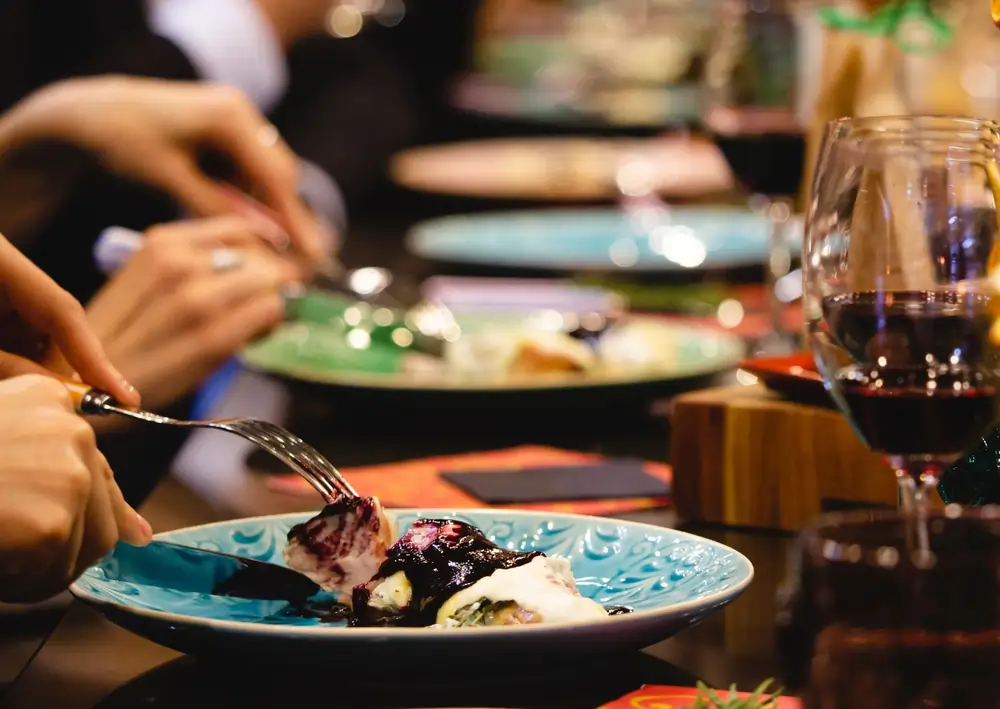In the bustling streets of Istanbul, the tantalizing aroma of spices lingers in the air, beckoning food enthusiasts from all corners of the globe. As the sun sets over the Bosphorus, Turkey’s rich culinary heritage comes alive, and the Anatolian cuisine offers a sensory journey like no other.
Turkey’s Rich Culinary Heritage

Turkey, a country bridging two continents, boasts a culinary tradition that spans thousands of years. Its unique geographical location, at the crossroads of Europe and Asia, has resulted in a diverse and vibrant cuisine influenced by various cultures and civilizations. From the ancient Hittites to the illustrious Ottoman Empire, each era has left an indelible mark on Turkey’s culinary tapestry.
The Anatolian region, in particular, is renowned for its rich culinary heritage. Nestled between the Black Sea and the Mediterranean, this vast landmass is home to a myriad of flavors and cooking techniques. From hearty kebabs to delicate pastries, Anatolian cuisine is a true reflection of the region’s history and cultural diversity.
The aim of this article is to delve into the depths of Anatolian cuisine, uncovering its hidden gems, and showcasing the culinary treasures that have captivated taste buds for centuries. By exploring the unique ingredients, traditional cooking methods, and regional specialties, we will unravel the secrets behind Anatolia’s gastronomic allure.
Anatolian cuisine has gained international recognition in recent years, attracting food enthusiasts and travelers alike. Its popularity has not only contributed to Turkey’s thriving tourism industry but has also elevated the country’s culinary reputation on the global stage. With its vibrant flavors, artful presentation, and emphasis on fresh, locally sourced ingredients, Anatolian cuisine has become a magnet for those seeking an authentic and unforgettable gastronomic experience.
The diverse range of dishes, from the succulent Adana kebab to the savory manti dumplings, has captivated the palates of visitors from around the world. The unique blend of spices, herbs, and aromatic ingredients creates a symphony of flavors that is both familiar and surprising. Moreover, the warm hospitality and culinary traditions passed down through generations add an extra layer of charm to the Anatolian dining experience.
As tourists flock to Turkey to savor the delights of Anatolian cuisine, local businesses and communities have thrived. Restaurants, food markets, and cooking classes have sprung up, offering visitors the opportunity to immerse themselves in the culinary traditions of the region. This culinary tourism has not only provided significant economic benefits but has also played a vital role in preserving and promoting Anatolian culinary heritage, ensuring its legacy for future generations.
Join us on this culinary journey as we explore the diverse and delicious world of Anatolian cuisine, uncovering its hidden treasures, and celebrating its enduring legacy.

Tom, Lead Clinic
Researcher and Writer
Hello! I’m Tom, and I’ve resided in Turkey for nearly ten years. I take great pleasure in offering travel tips for Turkey. I possess extensive knowledge of its hidden treasures and the finest ways to relish all that Turkey has to offer.
My main expertise lies in the booming Turkish health sector, and especially hair transplants.
If you’re curious about hair transplants in Turkey, you can check out my hair transplant Turkey reviews. Feel free to reach out to me if you want to learn more!
The Roots of Anatolian Cuisine
Anatolia, the vast peninsula located at the crossroads of Europe and Asia, has played a pivotal role in shaping the culinary traditions of the region. Its diverse geography, which encompasses mountains, plateaus, valleys, and a long coastline, has provided a rich tapestry of ingredients and flavors that have influenced Anatolian cuisine for centuries.

The mountainous regions of Anatolia, such as the Taurus and Pontic Mountains, have contributed to the development of hearty and robust dishes. The harsh climate and rugged terrain have necessitated the use of ingredients that are hardy and can withstand the challenging conditions. As a result, dishes like kebabs, stews, and pilafs, which are known for their bold flavors and substantial nature, have become staples of Anatolian cuisine.
On the other hand, the fertile valleys and plains of Anatolia have given rise to an abundance of agricultural produce. The region’s fertile soil and favorable climate have made it ideal for cultivating a wide variety of fruits, vegetables, and grains. Ingredients such as eggplants, peppers, tomatoes, olives, figs, and pistachios have become integral to Anatolian cuisine, adding vibrant colors, flavors, and textures to the dishes.
Furthermore, Anatolia’s long coastline along the Aegean, Mediterranean, and Black Seas has had a profound impact on the culinary traditions of the region. Seafood, including fish, mussels, and squid, has become a prominent feature in coastal Anatolian cuisine. The proximity to the sea has also introduced a range of spices and herbs, such as oregano, thyme, and mint, which are commonly used to enhance the flavors of seafood dishes.
Ancient civilizations and their impact on Turkish cuisine
The rich history of Anatolia is marked by the influence of various ancient civilizations, each leaving their indelible mark on Turkish cuisine. The Hittites, Greeks, and Romans, in particular, have played a significant role in shaping the culinary traditions of the region.
The Hittites, an ancient Anatolian civilization that thrived from the 18th to the 13th century BCE, introduced a range of cooking techniques and ingredients that are still prevalent in Turkish cuisine today. They were known for their advanced agricultural practices and the cultivation of grains such as barley and wheat. The Hittites also introduced the use of honey, which is still widely used in Turkish desserts and pastries.
The Greeks, who established colonies along the Anatolian coast during the 1st millennium BCE, brought with them a rich culinary heritage. Greek influence can be seen in dishes such as dolma (stuffed vegetables), baklava (a sweet pastry), and moussaka (a layered casserole). The Greeks also introduced olive oil, which has become a staple ingredient in Turkish cooking, adding depth and richness to various dishes.
During the Roman period, Anatolia became the breadbasket of the empire, supplying Rome with an abundance of agricultural produce. The Romans introduced new ingredients such as garum (a fermented fish sauce) and spices like cumin and coriander. They also brought advanced cooking techniques, including the use of ovens and the art of preserving food through salting and smoking.
Key ingredients and cooking techniques passed down through generations
Anatolian cuisine is characterized by the use of fresh, seasonal ingredients and cooking techniques that have been passed down through generations. These key ingredients and techniques form the foundation of Anatolian cooking and contribute to the unique flavors and textures of the cuisine.
One such ingredient is yogurt, which has been a staple in Anatolian cuisine for centuries. Yogurt is used in a variety of dishes, from soups and sauces to marinades and desserts. Its tangy flavor and creamy texture add depth and richness to many Anatolian dishes.
Another essential ingredient in Anatolian cuisine is bulgur, a cracked wheat product that is widely used in pilafs, salads, and soups. Bulgur adds a nutty flavor and chewy texture to dishes, making it a versatile and nutritious ingredient.
Cooking techniques such as grilling, roasting, and slow-cooking are also prominent in Anatolian cuisine. Grilling, especially over open flames, imparts a smoky flavor and charred exterior to meats and vegetables, while roasting brings out the natural sweetness and caramelization of ingredients. Slow-cooking, on the other hand, allows flavors to meld together and results in tender and succulent dishes.
The historical context of Anatolian cuisine reveals a fascinating interplay between geography, ancient civilizations, and culinary traditions. The diverse geography of Anatolia has provided a wide range of ingredients, while the influence of civilizations such as the Hittites, Greeks, and Romans has shaped the flavors and techniques of Turkish cuisine. By understanding the roots of Anatolian cuisine, we gain a deeper appreciation for the rich tapestry of flavors and traditions that continue to delight palates today.
Regional Flavors: A Journey through Turkey’s Culinary Map
The Aegean and Mediterranean Coasts of Turkey offer a tantalizing array of seafood-based specialties that reflect the region’s close proximity to the bountiful waters of the Aegean and Mediterranean Seas. From the bustling fish markets to the charming coastal restaurants, this region is a haven for seafood lovers.
One of the standout dishes in this region is Grilled Octopus. Tender and succulent, the octopus is marinated in a blend of olive oil, lemon juice, and fragrant herbs before being expertly grilled to perfection. The result is a dish that showcases the natural flavors of the sea, with a delightful smoky char that adds depth to every bite.
Stuffed Mussels, known as Midye Dolma, are another beloved specialty of the Aegean and Mediterranean Coasts. Fresh mussels are carefully opened, and their meat is mixed with a flavorful stuffing made from rice, herbs, and spices. The mixture is then delicately placed back into the mussel shells and steamed until the flavors meld together. The result is a delectable bite-sized treat that bursts with a harmonious blend of textures and tastes.
The cuisine of the Aegean and Mediterranean Coasts is characterized by its emphasis on fresh, high-quality ingredients, particularly olive oil, herbs, and fresh vegetables. Olive oil, often referred to as “liquid gold,” is a staple in this region and is used generously in both cooking and as a finishing touch to dishes.
Herbs such as oregano, thyme, and rosemary are abundant in the coastal regions, and they play a significant role in enhancing the flavors of the dishes. Whether sprinkled over grilled fish, mixed into marinades, or used to season salads, these aromatic herbs add a distinct Mediterranean touch to the cuisine.
Fresh vegetables also take center stage in the Aegean and Mediterranean Coasts’ culinary offerings. Locally grown tomatoes, cucumbers, peppers, and eggplants are used in a variety of dishes, including refreshing salads, hearty stews, and flavorful dips like the famous Turkish meze, known as cacık. These vegetables are celebrated for their vibrant colors, crisp textures, and exceptional taste, making them an integral part of the region’s cuisine.
The combination of olive oil, herbs, and fresh vegetables creates a symphony of flavors that is both light and satisfying. It is no wonder that the Aegean and Mediterranean Coasts are renowned for their healthy and delicious cuisine, which showcases the best of what nature has to offer.

Tom, Lead Clinic
Researcher and Writer
One cannot discuss Turkish cuisine without mentioning the iconic kebabs. These succulent grilled meats, whether it be lamb, chicken, or beef, are marinated in a blend of spices and served with a side of fluffy rice or warm bread.
The variety of kebabs, from the famous doner kebab to the mouthwatering shish kebab, is a testament to the creativity and skill of Turkish chefs. One of my personal favorites is YIldIz Bufe, a no frills restaurant with really good kebabs and juice. The restaurant is only a 5 minute walk from the Grand Bazaar, one of the Top 5 Instagrammable Spots in Istanbul.
Download the Hair Back App
Join the hair transplant community: discuss hair loss, get discounts and plan your aftercare treatment.
Turkish Breakfast: A Hearty Start to the Day
Turkish breakfast, known as “kahvaltı,” is a delightful and hearty affair that sets the tone for the rest of the day. It is a time-honored tradition that showcases the rich culinary heritage of Turkey. A typical Turkish breakfast spread consists of a variety of delectable items that cater to both savory and sweet palates.
One of the most iconic breakfast items in Turkey is the simit. These circular, sesame-covered bread rings are a staple and are often enjoyed with a spread of butter, honey, or a variety of cheeses. The combination of the crunchy exterior and soft interior makes simit a perfect accompaniment to any breakfast.
Another popular dish that graces Turkish breakfast tables is menemen. This flavorful dish is made by sautéing tomatoes, peppers, onions, and spices, then adding eggs to create a delicious scrambled egg and vegetable medley. Menemen is often served with fresh bread, providing a satisfying and wholesome start to the day.
No Turkish breakfast is complete without a steaming cup of çay, or Turkish tea. Turkish tea is brewed using a special two-tiered teapot called a çaydanlık. The lower pot holds boiling water, while the upper pot contains loose tea leaves. The tea is brewed strong and is traditionally served in small tulip-shaped glasses. The aromatic and robust flavor of Turkish tea perfectly complements the diverse flavors of the breakfast spread.
The Social Aspect of Breakfast in Turkish Culture
In Turkish culture, breakfast is more than just a meal; it is a social gathering that brings families and friends together. The act of sharing a meal in the morning fosters a sense of community and strengthens bonds between individuals. Turkish breakfasts often extend for hours, allowing for leisurely conversations and the enjoyment of each other’s company.
The concept of “kahvaltı sofrası,” or breakfast table, holds great importance in Turkish culture. It is a beautifully arranged table filled with a myriad of dishes, enticing colors, and aromas. The table is a reflection of Turkish hospitality and is often adorned with fresh fruits, olives, cucumbers, tomatoes, various cheeses, jams, and pastries.
The social aspect of Turkish breakfast extends beyond the family unit. Many cafes and restaurants in Turkey offer traditional breakfast spreads, allowing locals and tourists alike to experience the joy of a communal breakfast. These establishments often provide a cozy and welcoming atmosphere, encouraging patrons to relax, savor their meal, and engage in lively conversations.

Traditional Turkish Tea and Coffee Culture
Turkish tea, as mentioned earlier, is brewed using a unique two-tiered teapot called a çaydanlık. The lower pot is filled with water and brought to a boil, while the upper pot holds loose tea leaves. Once the water reaches a rolling boil, a portion is poured into the upper pot, allowing the tea leaves to steep. The remaining water in the lower pot is diluted with the tea from the upper pot, creating a balanced and flavorful brew. Turkish tea is often served with sugar cubes on the side, allowing individuals to sweeten their tea according to their preference.
Turkish coffee, on the other hand, is prepared using a special pot called a cezve. Finely ground coffee beans are mixed with water and sugar (optional) in the cezve and heated over low heat. As the coffee heats, it forms a frothy layer on top. Once the froth starts to rise, the cezve is removed from the heat to prevent it from boiling over. The coffee is then poured into small cups, allowing the grounds to settle before sipping. Turkish coffee is known for its strong and intense flavor, often enjoyed with a glass of water to cleanse the palate.

Anatolian Delights for Festive Occasions and Traditional Turkish Dishes
Turkish cuisine shines brightest during festive occasions and celebrations, where traditional dishes take center stage. One such iconic sweet treat is baklava. Layers of thin, flaky pastry are filled with a mixture of finely chopped nuts, sugar, and spices, then drenched in a sweet syrup made from honey or sugar. The result is a rich and indulgent dessert that is often enjoyed during religious holidays and special family gatherings.
Stuffed grape leaves, known as dolma, are another beloved dish that graces Turkish tables during festive occasions. Tender grape leaves are filled with a flavorful mixture of rice, herbs, and spices, then rolled into bite-sized parcels.

Anatolian Culinary Influences: Fusion and Modernization
The fusion of Middle Eastern, Balkan, and Central Asian influences in Ottoman cuisine resulted in a remarkable array of dishes that continue to tantalize taste buds to this day. One such example is the iconic Turkish dish, “Karnıyarık,” which translates to “split belly.” This delectable dish consists of eggplant stuffed with a mixture of ground meat, onions, tomatoes, and spices, reflecting the blend of flavors from the various regions.
Another dish that showcases the Ottoman Empire’s culinary prowess is “Manti,” a type of dumpling that resembles Italian tortellini. These tiny pockets of joy are typically filled with a mixture of ground meat, onions, and spices, and are served with a generous drizzle of melted butter and a dollop of tangy yogurt. The influence of Central Asian cuisine is evident in the use of dumplings, while the addition of yogurt reflects the Middle Eastern influence.
Contemporary Turkish cuisine: Western Culinary Influences in Urban Areas
In recent years, Turkish cuisine has experienced a renaissance, with the emergence of modern restaurants and the introduction of international flavors in major cities. Istanbul, in particular, has become a hub for culinary experimentation and fusion.
The rise of modern restaurants in urban areas has allowed Turkish chefs to explore Western culinary techniques and incorporate them into traditional Turkish dishes. This cross-pollination of flavors has resulted in a vibrant and innovative food scene that appeals to both locals and tourists alike.
Contemporary Turkish cuisine has witnessed a delightful fusion of Turkish and Western flavors, creating a harmonious blend that satisfies the palates of even the most discerning food enthusiasts. One notable example is the dish “Lahmacun,” often referred to as Turkish pizza. This thin and crispy flatbread is topped with a flavorful mixture of minced meat, tomatoes, onions, and a medley of herbs and spices. The influence of Italian cuisine is evident in the concept of a flatbread topped with savory ingredients, while the use of Middle Eastern spices adds a distinct Turkish touch.
Furthermore, the popular street food “Döner Kebab” has undergone a Western-inspired transformation, giving birth to the mouthwatering “Iskender Kebab.” Traditionally, Döner Kebab consists of succulent slices of marinated meat served in a warm pita bread. However, the Iskender Kebab takes it a step further by adding a layer of melted butter, a generous drizzle of tomato sauce, and a dollop of yogurt, creating a delightful fusion of Turkish and Western flavors.
Top Rated Hair Transplant Clinics in Istanbul
Culinary Tourism: Exploring Anatolian Delights
Turkey, with its rich culinary heritage, offers a plethora of food destinations that are a feast for both the eyes and the taste buds. Among the top culinary hotspots in the country, Istanbul, Gaziantep, and Antalya stand out as must-visit cities for food enthusiasts.
Popular food destinations in Turkey
1. Istanbul: A melting pot of cultures and flavors, Istanbul offers a diverse culinary experience. From the vibrant street food scene in the bustling neighborhoods of Eminönü and Karaköy to the upscale restaurants in Beyoğlu and Beşiktaş, the city caters to all palates. Don’t miss the opportunity to indulge in iconic dishes like kebabs, baklava, and Turkish tea while exploring the historic Spice Bazaar and the vibrant Kadikoy Food Market.
2. Gaziantep: Known as the culinary capital of Turkey, Gaziantep is a food lover’s paradise. Renowned for its rich and flavorful dishes, this city is a treasure trove of traditional Anatolian cuisine. Be sure to sample the famous baklava, pistachios, and kebabs, which are all staples of Gaziantep’s gastronomic heritage. Explore the local markets, such as Zincirli Bedesten, and witness the artistry of local chefs as they prepare dishes like lahmacun and katmer right before your eyes.
3. Antalya: Located on the stunning Mediterranean coast, Antalya not only offers breathtaking views but also a vibrant culinary scene. With its abundance of fresh seafood, citrus fruits, and aromatic herbs, this city is a haven for food lovers. Indulge in a seafood feast at the picturesque Old Harbor, where you can savor grilled octopus, shrimp casserole, and stuffed mussels. For a taste of authentic Turkish cuisine, head to Kaleiçi, the historic neighborhood, and explore its charming restaurants serving traditional dishes like mantı (Turkish dumplings) and pide (Turkish pizza).
Local markets, street food, traditional restaurants and other must-visit spots
When exploring Anatolian delights, it is essential to venture into local markets, savor street food, and dine at traditional restaurants to truly experience the authentic flavors of Turkey.
1. Istanbul’s Spice Bazaar: Step into the vibrant and aromatic world of Istanbul’s Spice Bazaar, where a kaleidoscope of colors and scents awaits. Explore the stalls filled with exotic spices, dried fruits, and nuts. Indulge in a cup of Turkish tea while sampling local delights like Turkish delight and lokum. Don’t forget to stock up on traditional spices like sumac, saffron, and cumin to recreate the flavors of Turkey at home.
2. Gaziantep’s Street Food: Gaziantep’s streets are lined with food stalls offering a wide array of mouthwatering street food. Try lahmacun, a thin and crispy Turkish pizza topped with minced meat and vegetables, or sink your teeth into a juicy Adana kebab, made with spiced ground lamb. For dessert, sample künefe, a sweet cheese pastry soaked in syrup and topped with crushed pistachios. These street food delights are not to be missed for an authentic taste of Gaziantep.
3. Antalya’s Traditional Restaurants: In Antalya, traditional restaurants provide a glimpse into the region’s culinary heritage. Dine in charming establishments that serve dishes made with locally sourced ingredients. Indulge in a hearty plate of mantı, delicate dumplings filled with ground meat and served with yogurt and garlic sauce. Savor the flavors of pide, a thin and crispy Turkish pizza topped with various ingredients like cheese, meat, or vegetables. These traditional restaurants offer a warm and inviting atmosphere, allowing you to savor the true essence of Antalya’s cuisine.
Download our free e-book sponsored by IdealofMeD, the #1 top rated clinic overall in Turkey. Over 100 pages about hair loss and hair restoration.


Experience the unique flavors of Anatolia
To truly understand and appreciate the culinary treasures of Turkey, one must embark on a gastronomic adventure through the country. From the vibrant food markets of Istanbul to the hidden gems tucked away in the narrow streets of Gaziantep, there is an endless array of culinary delights waiting to be discovered.
We encourage readers to explore the local cuisine, engage with the friendly locals, and immerse themselves in the vibrant food culture of Turkey. Whether it’s indulging in a traditional Turkish breakfast spread, savoring the aromatic flavors of a slow-cooked lamb stew, or delighting in the sweet notes of a baklava, each bite will be a journey of flavors and a celebration of Anatolian culinary heritage.

Tom, Lead Clinic
Researcher and Writer
My Final Tips
For those seeking a curated culinary experience, I recommend embarking on a food tour in Turkey. These guided tours offer a unique opportunity to sample a wide variety of dishes, explore local markets, and learn from knowledgeable guides who are passionate about Turkish cuisine. Some popular food tour companies include Istanbul Eats, Culinary Backstreets, and Taste of Turkey.
Alternatively, if you prefer to discover the culinary treasures of Turkey at your own pace, I suggest visiting renowned restaurants that showcase the best of Anatolian cuisine. In Istanbul, consider dining at Çiya Sofrası or Mikla for a modern twist on traditional dishes. In Cappadocia, a visit to Old Greek House or Seten Anatolian Restaurant will transport you to a world of authentic flavors.
The culinary treasures of Turkey are a journey of flavors and a celebration of Anatolian culinary heritage. By exploring the richness and diversity of Turkish cuisine, we not only satisfy our taste buds but also gain a deeper understanding of the country’s history, culture, and people. So, let us embark on this gastronomic adventure, preserving and promoting the unique flavors of Anatolia for generations to come.

